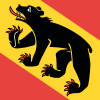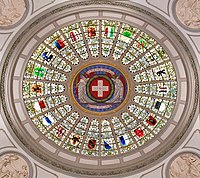Canton of Bern
Canton of Bern
| |
|---|---|
 Location in Switzerland
Map of Bern Aare at Wynau | |
| Joined | 1353 |
| Languages | German, French |
| Website | www |
The canton of Bern, or Berne (
Comprising
The canton of Bern is
Formerly part of the Holy Roman Empire, the canton of Bern entered an alliance with the Swiss Forest Cantons in 1323 and joined the Old Swiss Confederacy in 1353.
History
Bern joined the
Early prehistory
The earliest traces of a human presence in the area of the modern Canton is found in three caves in the
One of the best explored neolithic sites is at
Iron Age

During the
The grave goods show that iron was forged into swords, daggers, spearheads, knives and wagon accessories. Gold, which was probably collected from river sand, was made into diadems, rings and pendants. Thin bronze arm, leg and neck plates with geometric designs were often buried, especially in the graves at Allenlüften in Mühleberg, at Ins and at Bützberg. The jewelry that was buried included bracelets and rings which were also made of
The transition to the
Roman era

After the
The existing roads were expanded, especially the
Under the Romans, many of the old fortified places were expanded and refortified. The old Helvetii oppidum at the Engehalbinsel became a Roman vicus, which was probably known as Brenodor or Brenodurum. At the foot of the Jens mountain, the fort Petinesca was built to guard the roads over the Jura Mountains. This was reinforced in the late-Roman era (368–369 CE) by a fortified bridge over the Thielle/Zihl river between Aegerten and Brügg.
A number of Roman villas were built around the Canton. At Oberwichtrach both the main building (pars urbana) and the industrial section (pars rustica) of a Roman villa have been discovered. The villas at Münsingen, Toffen and Herzogenbuchsee have richly detailed Roman mosaics that are still partly visible.
The religious practices of the local population merged with Roman beliefs and the Canton of Bern is home to a number of unique cult centers. They include the larger than life statues of gods (including enthroned Jupiter) at Petinesca, Engehalbinsel, and Thun-Allmendingen; and a number of stone inscriptions. At the beginning of the 5th century CE, Rome withdrew its troops from the Rhine garrisons, but allowed the Burgundians to settle on Helvetii lands in 443 CE.[4]
Early Middle Ages

East of the
Christianity spread slowly into the Aare valley. The dioceses of
Middle Ages
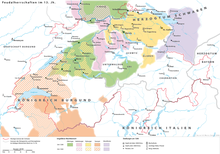
During the 10th century, the Aare valley came fully under the
The succession dispute following the death of
During the
During the 13th century a number of the cities near Bern were granted the
In 1298 Bernese forces won a victory at Oberwangen in Köniz against the County of Savoy and the Habsburg Austrian nobility. In 1300, the city acquired the four surrounding parishes of Bolligen, Vechigen, Stettlen and Muri, destroyed the threatening castles of Bremgarten and Belp and gave the Baron of Montenach Bernese citizenship. After the victory of Louis IV of Bavaria over the Habsburg Frederick the Fair in the battle of Mühldorf (Bavaria) in 1322, Bern entered an alliance with the anti-Habsburg Swiss Forest Cantons in 1323.
Old Swiss Confederacy



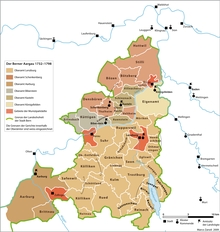

Bern joined the
14th century
In 1310 Emperor Henry VII pledged Laupen Castle, Laupen and the surrounding lands as collateral for a loan. In 1324, Bern acquired the pledged castle and lands. When the Emperor was unable to repay the loan, Laupen became the first bailiwick of Bern.[7]
In 1322, the brothers Eberhard II of
In 1334, Bern fought with the Barons of Weissenburg and occupied Wimmis and Unspunnen in the Oberland. Bern's victory allowed them to bring the Oberhasli region, its capital of Meiringen and Weissenburg under their control. Bern's continued expansion was at the expense of the feudal lords in the surrounding lands. In 1339 the Habsburgs, Kyburgs and Fribourg, marched against Bern with 17,000 men and besieged the border town of Laupen. To raise the siege, Bern raised a force of 6,000, consisting of Bernese, supported by the Forest Cantons, and other allies (Simmental, Weissenbur and Oberhasli).[9] The allied Bernese forces were victorious at the Battle of Laupen and Bern drew closer to the Swiss Forest Cantons. It entered into a permanent or eternal alliance with Uri, Schwyz and Unterwalden in 1353. This date is usually considered the date of Bern's entrance into the Swiss Confederation; however, the alliance only indirectly tied Bern to Zürich and Lucerne.
In 1358 the cash-strapped Count Peter II of Aarberg pawned the County of Aarberg to Bern. However, in 1367 he sold it, without repaying Bern, to his cousin Rudolf IV of Nidau. After Rudolf's death (1375) Bern acquired clear right to the Aarberg lands from the other heirs.[10]
Throughout the 14th century, Bern entered into alliances and treaties with many of its neighbors, including members of the
By the 1370s, the Kyburgs (which still held Thun as a fief for Bern) were deeply in debt to Bern. On 11 November 1382, Rudolf II of Neu-Kyburg made an unsuccessful raid on Solothurn. The ensuing conflict with the Old Swiss Confederacy (known as the Burgdorferkrieg or Kyburgerkrieg) allowed Bern to move against the Habsburgs in Aargau. After the Bernese laid siege to Burgdorf, Neu-Kyburg was forced to concede an unfavourable peace.[11] Bern bought Thun and Burgdorf, the most important cities of Neu-Kyburg, and their remaining towns passed to Bern and Solothurn by 1408. The last of the Neu-Kyburgs, Berchtold, died destitute in Bern in 1417.[8]
In 1386, the
15th century
By 1400, Bern controlled the entire Bernese Oberland. Under their control, the five valleys of the Oberland enjoyed extensive rights and far-reaching autonomy in the Bäuerten (farming cooperative municipalities) and Talverbänden (rural alpine communities). However, throughout the Late Middle Ages, the Oberland, as a whole or in part, revolted several times against Bernese authority. The Evil League (Böser Bund) in 1445 fought against Bernese military service and taxes following the Old Zürich War,[12] in 1528 the Oberland rose up in resistance to the Protestant Reformation and in 1641 Thun revolted.[13]
In the Bernese Oberland during the 13th and the beginning of the 14th century

The lands around the northern shore of Lake Geneva and between Lake Neuchâtel were the next area into which Bern expanded. The region had originally been part of the Carolingian Empire. Then, in 1032 the Zähringens of Germany defeated the Burgundians, who were then replaced by the counts of Savoy in 1218. Under the counts of Savoy the area was given political unity, and established as the Barony of Vaud. However, as the power of the Savoys declined at the beginning of the 15th century the land was occupied by troops from Bern. By 1536 the area was completely annexed. Reformation was started by co-workers of John Calvin, including Viret, who engaged in a famous debate at the cathedral of Lausanne; but it was only decisively implemented when Bern put its full force behind it. Vaud was another French-speaking region in the mostly German-speaking canton, which caused several uprisings.
Both Château-d'Œx and Saanen were part of the county of Gruyère. Both districts had quite a bit of independence and often entered into treaties against the will and best interests of the Counts. In 1340 the Saanen valley concluded a peace treaty with the Simmental, which provided for arbitration in disputes. They entered into another treaty in 1393 with the Valais. In 1401, Count Rudolph of Gruyère entered into a treaty with Bern which included Saanen. Two years later Saanen[15] and Château-d'Œx[16] negotiated their own alliances with Bern. Due to the Bernese alliance, Saanen sent troops, under their own banner, to support the Bernese invasions of Aargau in 1415 and Valais in 1418. The military losses and taxes following the Old Zürich War led Saanen to support the Evil League (Böser Bund) in 1445 against Bern.
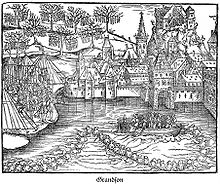
In 1475, during the
During the Burgundian War in 1475, Saanen, together with troops from Château-d'Œx and the Simmental captured the Savoy district of Aigle for Bern. Saanen and the surrounding district enjoyed a great deal of independence during the 16th century. However, in 1555 the last
Acquired districts
The area of the canton of Bern consists of lands acquired by the city of Bern mostly between the 14th and the 16th century during the original
Acquired districts, with dates of acquisition, include:
- Laupen (1324)
- Oberhasli (1334)
- Aarberg (1375)
- Thun and Burgdorf (1384)
- Unterseen and the Upper Simme valley (1386)
- Frutigen and other towns in the Bernese Oberland (1400)
- Aargau (1415)
- Lower Simme valley (1439–1449)
- Aigle and Grandson (1475)
- Interlaken, with Grindelwald, Augustinian Canons at Interlaken Monastery)
- Vaud (1536)
- Saanen or Gessenay (1555)
- the Pays d'En-Haut including Château-d'Œx (1555)
- Köniz (1729).
Social changes in Early Modern Bern
In the Middle Ages, upwards mobility and access to public offices was relatively easy for successful traders and craftsmen, but Bernese society became ever more stratified and aristocratic as the power and wealth of the city grew.
By the 17th century in the
In Vaud the Bernese occupation was not popular amongst the population. In 1723, Major Abraham Davel led a revolt against Bern, in protest at what he saw as the denial of political rights of the French-speaking Vaudois by the German-speaking Bernese, and was subsequently beheaded.[20]
Napoleonic period
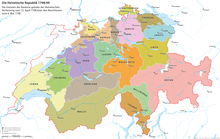
Inspired by the
In 1798, with the establishment of the Helvetic Republic, Bern was divided, the canton of Oberland with Thun as its capital and the canton of Léman with Lausanne as its capital were detached from what was left of the Canton of Bern.
Within the new canton of Oberland, historic borders and traditional rights were not considered. As there had been no previous separatist feeling amongst the conservative population, there was little enthusiasm for the new order.[13] The situation in the canton of Léman was quite different. The French-speaking Vaudois had never felt like part of the German-speaking Canton of Bern. When they joined the Swiss Confederation in 1803, it was as the Canton of Vaud.
Under the Helvetic Republic, Pays-d'Enhaut with Château-d'Œx became part of the Canton of Léman while Saanen and the rest of the district became part of the Canton of Oberland. When the Helvetic Republic collapsed in 1803, Saanen and its district became a district in the new Canton of Bern[15] while Château-d'Oex and its district joined Vaud.
The 1801
Between 1803 and 1814 Bern was one of the six directorial cantons of the
Modern history
With the post−Napoleonic
Bern still remained the largest canton of the confederacy from 1815 to 1979, when parts of the Bernese Jura broke away to form the
Geography

The canton of Bern is mainly drained by the river
The area of the canton is 5,959 km2 (2,301 sq mi). Of this area, 6.9% is occupied with houses, businesses or roads. 42.6% of the canton is agricultural land, and 31.3% is forested. Less than 19.2% is considered non-productive, which includes glaciers, cliffs and lakes.[23]
Bernese Mittelland
The Bernese Mittelland (Bernese Midlands) is made up of the valley of the rivers Aare, the
Three Lakes Region and Bernese Jura
In the north of the canton lies the predominantly French-speaking Three Lakes Region (
Bernese Oberland
The Bernese Oberland (German: Berner Oberland) constitute the north side of the
The well known hiking and ski resorts in the eastern Oberland are located around
.The whole area is very mountainous, with steep cliffs, many glaciers, and countless waterfalls. It is renowned for its scenic beauty and the charm of the small Swiss villages that dot the area. As a result of this, tourism is one of the main sources of income in the Bernese Oberland. The region also has an extensive train network as well as many
Mountains in the Bernese Oberland include:

|
Government

The Grand Council of Bern (German: Grosser Rat/French: Grand conseil) is the parliament of the canton of Bern. It consists of 160 representatives elected by proportional representation for four-year terms of office. The French-speaking part of the canton, the Bernese Jura, has 12 seats guaranteed and 3 seats are guaranteed for the French-speaking minority of the bilingual district of Biel/Bienne.
The Executive Council of Bern (German: Regierungsrat/French: Conseil-éxecutif) is the government of the canton of Bern. This seven-member collegial body is elected by the people for a period of four years. The cantonal constitution reserves one seat in the Executive Council for a French-speaking citizen from the Bernese Jura.
The canton has a two-tiered court system, consisting of district courts and a cantonal Supreme Court (German: Obergericht, French: Cour suprême). There is also an administrative court (German: Verwaltungsgericht; French: Tribunal administratif) as well as other specialised courts and judicial boards.[24]
Political subdivisions

On 1 January 2010, the 26 districts (
- Seftigen
- Nidau
- Trachselwald
- Niedersimmental
- Oberhasli
- La Neuveville
- Wangen
- Saanen
- Nidau
- Thun
Demographics
The canton of Bern is
In December 2020, Bern had a population of 1,043,132.[2] In 2014, 15.0% of the population were resident foreign nationals. From 2010 to 2014, the population increased at a rate of 3.0% annually. In 2000, most of the population spoke German (804,190 or 84.0%) as their first language; French was the second most common (72,646 or 7.6%) native language and Italian was the third (18,908 or 2.0%). There were 688 people who speak Romansh.[27] Using different methodology, the 2014 census found that the proportion of German native speakers to be 85.1%, that of French speakers 10.4%, and that 3.1% were Italian speakers. The number of Romansh speakers was too small to accurately estimate, but was around 0.1%. The census also reported that 2.9% of the population spoke English as their native language. Respondents could choose up to three native languages, leading to a total above 100%.[26]
In 2008, the population was 47.5% male and 52.5% female. The population was made up of 44,032 Swiss men (35.4% of the population) and 15,092 (12.1%) non-Swiss men. There were 51,531 Swiss women (41.4%) and 13,726 (11.0%) non-Swiss women.[28] Of the population in the canton, 292,559 or about 30.6% were born in Bern and lived there in 2000. There were 339,659 or 35.5% who were born in the same canton, while 154,709 or 16.2% were born somewhere else in Switzerland, and 129,864 or 13.6% were born outside of Switzerland.[27]
The age distribution of the canton in 2014 was as follows: those from 0–19 years old made up 19.1% of the population, while those aged 20–64 years old were 60.9%, and those 65 and older comprised.[26] The 2000 census had found these groups to represent 22%, 60.9% and 17.1% of the total, respectively.
In 2000, there were 397,095 people who were single and never married in the canton. There were 449,014 married individuals, 61,206 widows or widowers and 49,882 individuals who are divorced.[27]
There were 454,000 private households in the canton in 2014, and an average of 2.2 persons per household.[26] As of 2013[update], the construction rate of new housing units was 4.4 new units per 1000 residents.[26]
In 2003, the average price to rent an average apartment in Bern city was 1108.92 Swiss francs (CHF) per month (US$890, £500, €710 approx. exchange rate from 2003). The average rate for a one-room apartment was 619.82 CHF (US$500, £280, €400), a two-room apartment was about 879.36 CHF (US$700, £400, €560), a three-room apartment was about 1040.54 CHF (US$830, £470, €670) and a six or more room apartment cost an average of 2094.80 CHF (US$1680, £940, €1340). The average apartment price in Bern was 99.4% of the national average of 1116 CHF.[29] The vacancy rate for the canton, in 2010[update], was 1.19%.[26]
Historic population
The historical population is given in the following chart:[30]

| Historic Population Data[4] | |||||||||||
|---|---|---|---|---|---|---|---|---|---|---|---|
| Year | Total Population | German Speaking | French Speaking | Protestant | Catholic | Other | Jewish | Christian Catholic | No religion given | Swiss | Non-Swiss |
| 1850 | 458,301 | 403,768 | 54,045 | 488 | |||||||
| 1860 | 413,887 | ||||||||||
| 1870 | 444,430 | ||||||||||
| 1880 | 471,991 | ||||||||||
| 1888 | 476,564 | ||||||||||
| 1900 | 589,433 | 483,388 | 97,789 | 506,699 | 80,489 | 970 | 1,543 | ||||
| 1910 | 578,381 | ||||||||||
| 1920 | 607,107 | ||||||||||
| 1930 | 623,665 | ||||||||||
| 1941 | 662,683 | ||||||||||
| 1950 | 801,943 | 665,702 | 120,566 | 671,817 | 122,971 | 3,189 | 1,403 | 3,256 | |||
| 1960 | 813,601 | ||||||||||
| 1970 | 901,706 | ||||||||||
| 1980 | 898,397 | ||||||||||
| 1990 | 958,192 | 802,740 | 74,338 | 691,812 | 172,906 | 53,880 | 802 | 1,263 | 41,350 | 860,655 | 97,537 |
| 2000 | 957,197 | ||||||||||
Politics
In the 2011 federal election, the most popular party was the SVP which received 29.0% of the vote. The next three most popular parties were the SP/PS (19.3%), the BDP (14.9%) and the Green Party (9.4%).[31] The SVP received about the same percentage of the vote as they did in the 2007 Federal election (33.6% in 2007 vs 29.0% in 2011). The SPS retained about the same popularity (21.2% in 2007), the BDP moved from below fourth place in 2007 to third and the GPS moved from below fourth place in 2007 to fourth.[32]
Federal election results
| Percentage of the total vote per party in the canton in the federal elections, 1971–2019[33][34] | |||||||||||||||
|---|---|---|---|---|---|---|---|---|---|---|---|---|---|---|---|
| Party | Ideology | 1971 | 1975 | 1979 | 1983 | 1987 | 1991 | 1995 | 1999 | 2003 | 2007 | 2011 | 2015 | 2019 | |
FDP.The Liberalsa
|
Classical liberalism | 17.3 | 17.6 | 18.0 | 15.1 | 16.1 | 13.7 | 15.6 | 17.2 | 14.8 | 15.1 | 8.7 | 9.3 | 8.4 | |
| CVP/PDC/PPD/PCD | Christian democracy | 5.3 | 5.3 | 2.5 | 2.1 | 2.4 | 2.6 | 1.9 | 2.4 | 2.3 | 4.7 | 2.1 | 1.8 | 1.9 | |
| SP/PS | Social democracy | 31.0 | 31.0 | 30.5 | 28.3 | 22.3 | 20.0 | 24.7 | 27.6 | 27.9 | 21.2 | 19.3 | 19.7 | 16.8 | |
| SVP/UDC | National conservatism | 29.2 | 27.1 | 31.5 | 29.0 | 27.8 | 26.3 | 26.0 | 28.6 | 29.6 | 33.6 | 29.0 | 33.1 | 30.0 | |
| LPS/PLS | Classical liberalism | *b | * | * | * | * | * | 0.3 | * | * | * | * | * | * | |
| Ring of Independents | Social liberalism | 6.3 | 4.7 | 3.1 | 3.2 | 3.6 | 2.9 | 1.9 | 0.8 | * | * | * | * | * | |
| EVP/PEV | Christian democracy | 4.1 | 3.5 | 3.4 | 3.3 | 3.4 | 3.3 | 3.8 | 4.0 | 5.2 | 5.4 | 4.2 | 4.3 | 4.2 | |
| CSP/PCS | Christian socialism | 0.9 | 0.9 | * | * | * | * | * | * | * | * | * | * | * | |
| GLP/PVL | Green liberalism | * | * | * | * | * | * | * | * | * | * | 5.3 | 6.0 | 9.7 | |
| BDP/PBD | Conservatism | * | * | * | * | * | * | * | * | * | * | 14.9 | 11.8 | 8.0 | |
| PdA/PST-POP/PC/PSL | Socialism | * | 0.6 | 0.3 | * | * | 0.2 | * | * | * | * | 0.3 | 0.5 | 0.6 | |
| PSA | Socialism | * | * | c | c | * | * | * | * | * | * | * | * | * | |
| POCH | Communism | * | 0.5 | 1.4 | 1.6 | d | e | * | * | * | * | * | * | * | |
| GPS/PES | Green politics | * | * | * | * | 9.2 | 9.9 | 5.9 | 7.5 | 9.3 | 12.9 | 9.4 | 8.5 | 13.6 | |
| FGA | Feminism | * | * | 1.1 | 2.2 | 2.6 | 2.0 | 2.5 | f | * | * | * | * | * | |
| SD/DS | National conservatism | 3.7 | 3.4 | 3.6 | 6.0 | 3.2 | 6.0 | 5.5 | 3.7 | 2.7 | 1.5 | 0.6 | 0.4 | 0.4 | |
| EDU/UDF | Christian right | * | 1.1 | 1.2 | 1.8 | 2.7 | 3.4 | 4.2 | 4.0 | 4.1 | 3.6 | 3.1 | 2.8 | 2.5 | |
| FPS/PSL | Right-wing populism | * | * | * | * | 3.2 | 6.8 | 5.9 | 2.7 | 1.1 | 0.6 | * | * | * | |
| Separatist parties | * | 1.8 | 2.8 | 2.2 | 1.0 | 1.7 | 1.5 | * | 1.9 | * | * | * | * | ||
| Other | 0.0 | 0.2 | 0.6 | 5.2 | 2.6 | 1.2 | 0.5 | 1.6 | 1.1 | 1.3 | 3.2 | 1.7 | 3.9 | ||
| Voter participation % | 58.0 | 54.3 | 49.8 | 49.9 | 45.7 | 46.2 | 40.4 | 41.1 | 42.1 | 46.4 | 50.4 | 49.1 | 47.3 | ||
- ^a FDP before 2009, FDP.The Liberals after 2009
- ^b "*" indicates that the party was not on the ballot in this canton.
- ^c Part of a coalition with Separatist Party
- ^d Part of a coalition with the FGA
- ^e Party fragmented, part remained in a coalition with the FGA and the remainder formed the Green Party of Bern
- ^f Part of a coalition with the Green Party
Coat of arms
The blazon of the coat of arms is Gules, on a bend or, a bear passant sable, langued, armed and vilené of the field. The official blazon specifies that the tongue, claws and penis are red—and by extension it is important to always depict the bear as male.[35]
Religion

Most Bernese are Protestant (as of 2000[update], 67%),
Bern features substantial Roman Catholic (16%)
From the 2000 census[update], 607,358 or 63.5% belonged to the
Economy
Tourism is the main source of income in the Bernese Oberland. Other important sectors are agriculture (especially cattle breeding), cheese making, and hydroelectric power generation. The Bernese cheese
The area around Lake Biel is renowned for its wine production. The 3 French-speaking districts of the Bernese Jura and the bilingual district of Biel/Bienne are renowned for their watch industry and its mechanical industry (high precision machine tools, automation and machining).
As of 2015[update], Bern had an unemployment rate of 2.58%, compared to the Swiss national average of 3.3%. As of 2013[update], there were 34,200 people employed in the primary economic sector and about 11,563 businesses involved in this sector. About 132,800 people were employed in the secondary sector and there were 11,925 businesses in this sector. Approximately 453,800 people were employed in the tertiary sector, with 55,347 businesses in this sector.[26] Of the working population, 31.0% used public transportation to get to work, and 51.0% used a private car.[26]
Education
In Bern about 385,640 or (40.3%) of the population have completed non-mandatory upper secondary education, and 121,749 or (12.7%) have completed additional higher education (either university or a Fachhochschule). Of the 121,749 who completed tertiary schooling, 65.0% were Swiss men, 24.8% were Swiss women, 6.2% were non-Swiss men and 4.0% were non-Swiss women.[27]
See also
- Municipalities of the canton of Bern
- Canton of Bern castles and fortresses
- List of mountains of the canton of Bern
- Berner Zeitung
- Bernese March
- Bieler Tagblatt
- Der Bund
Notes and references
- ^ Arealstatistik Land Cover - Kantone und Grossregionen nach 6 Hauptbereichen accessed 27 October 2017
- ^ a b c "Ständige und nichtständige Wohnbevölkerung nach institutionellen Gliederungen, Geburtsort und Staatsangehörigkeit". bfs.admin.ch (in German). Swiss Federal Statistical Office - STAT-TAB. 31 December 2020. Retrieved 21 September 2021.
- ^ Statistik, Bundesamt für (21 January 2021). "Bruttoinlandsprodukt (BIP) nach Grossregion und Kanton - 2008-2018 | Tabelle". Bundesamt für Statistik (in German). Retrieved 1 July 2023.
- ^ a b c d e f g h i Canton of Bern in German, French and Italian in the online Historical Dictionary of Switzerland.
- ^ Centre, UNESCO World Heritage. "Prehistoric Pile Dwellings around the Alps". UNESCO World Heritage Centre.
- ISBN 9781315425047.
- ^ Laupen in German, French and Italian in the online Historical Dictionary of Switzerland.
- ^ a b von Kyburg in German, French and Italian in the online Historical Dictionary of Switzerland.
- ISBN 1-85367-105-3.
- ^ Aarberg (Herrschaft, Amtsbezirk) in German, French and Italian in the online Historical Dictionary of Switzerland.
- ^ Burgdorferkrieg in German, French and Italian in the online Historical Dictionary of Switzerland.
- ^ Böser Bund in Berner Oberland in German, French and Italian in the online Historical Dictionary of Switzerland.
- ^ a b Bernese Oberland in German, French and Italian in the online Historical Dictionary of Switzerland.
- ^ Interlaken Monastery and District in German, French and Italian in the online Historical Dictionary of Switzerland.
- ^ a b c Saanen district in German, French and Italian in the online Historical Dictionary of Switzerland.
- ^ a b Château-d'Oex in German, French and Italian in the online Historical Dictionary of Switzerland.
- ^ Aigle in German, French and Italian in the online Historical Dictionary of Switzerland.
- ^ Grandson district in German, French and Italian in the online Historical Dictionary of Switzerland.
- ^ Coolidge, Rev. William Augustus Brevoort (1911). . In Chisholm, Hugh (ed.). Encyclopædia Britannica. Vol. 3 (11th ed.). Cambridge University Press. p. 795.
- ^ Histoire de la Suisse, Éditions Fragnière, Fribourg, Switzerland.
- ^ Canton of Oberland in German, French and Italian in the online Historical Dictionary of Switzerland.
- ^ Kanton Bern, Regionen Archived 1 January 2009 at the Wayback Machine (german). Retrieved 30 July 2009
- ^ Swiss Federal Statistical Office – Key Data. Retrieved 18 August 2020
- ^ "Gerichte und Strafverfolgungsbehörden des Kantons Bern". Kanton Bern. Archived from the original on 1 September 2005.
- ^ Amtliches Gemeindeverzeichnis der Schweiz, Mutationsmeldungen 2009 / Répertoire officiel des communes de Suisse, Mutations 2009 / Elenco ufficiale dei Comuni della Svizzera, Mutazione 2009 (PDF) (Report). Federal Statistical Office. 2009. nden. Archived from the original (PDF) on 18 November 2010. Retrieved 6 March 2010.
- ^ a b c d e f g h "Regional comparison of selected indicators (Cantons)Kanton". Swiss Federal Statistical Office. Archived from the original on 14 February 2016. Retrieved 8 February 2016.
- ^ a b c d e STAT-TAB Datenwürfel für Thema 40.3 – 2000 Archived 9 April 2014 at the Wayback Machine (in German). Retrieved 2 February 2011
- ^ Statistical office of the Canton of Bern Archived 15 February 2012 at the Wayback Machine (in German). Retrieved 4 January 2012
- ^ Swiss Federal Statistical Office-Rental prices Archived 23 April 2010 at the Wayback Machine 2003 data (in German). Retrieved 26 May 2010
- ^ Swiss Federal Statistical Office STAT-TAB Bevölkerungsentwicklung nach Region, 1850–2000 Archived 30 September 2014 at the Wayback Machine (in German). Retrieved 29 January 2011
- ^ Swiss Federal Statistical Office, Elections in Switzerland Archived 11 January 2012 at the Wayback Machine (in German). Retrieved 5 January 2012
- ^ Swiss Federal Statistical Office, Nationalratswahlen 2007: Stärke der Parteien und Wahlbeteiligung, nach Gemeinden/Bezirk/Canton Archived 14 May 2015 at the Wayback Machine (in German). Retrieved 28 May 2010
- ^ Nationalratswahlen: Stärke der Parteien nach Kantonen (Schweiz = 100%) (Report). Swiss Federal Statistical Office. 2015.
- ^ "Eidgenössische Wahlen 2019". opendate.swiss. Swiss Federal Statistical Office. 20 October 2019. Retrieved 12 November 2019.
- ^ Flags of the World.com. Retrieved 8 January 2012
- ^ a b Federal Department of Statistics (2004). "Wohnbevölkerung nach Religion". Archived from the original (Interactive Map) on 24 September 2016. Retrieved 15 January 2009.
- Swissinfo. 5 September 2006. Retrieved 10 February 2006.

